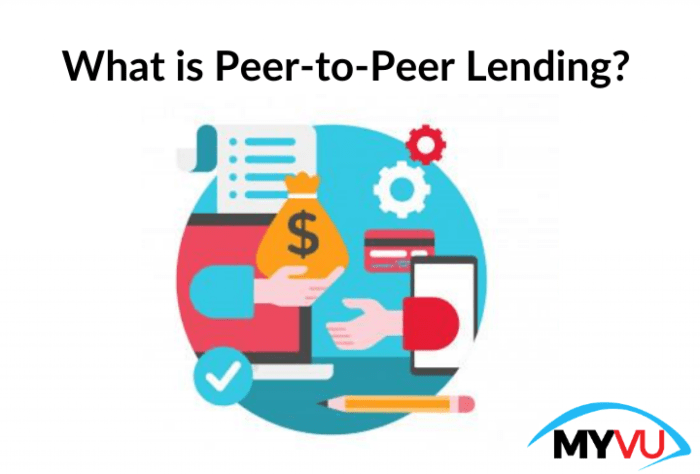Diving into Peer-to-peer lending, this introduction immerses readers in a unique and compelling narrative, with an American high school hip style that is both engaging and thought-provoking from the very first sentence.
As we explore the ins and outs of Peer-to-peer lending, get ready to uncover the secrets behind this innovative financial practice that is reshaping the lending landscape.
Overview of Peer-to-peer lending

Peer-to-peer lending, also known as P2P lending, is a method of borrowing and lending money without the use of traditional financial institutions like banks. Instead, individuals can directly lend money to other individuals or businesses through online platforms.
How Peer-to-peer lending platforms operate
Peer-to-peer lending platforms act as intermediaries, matching borrowers with lenders based on their preferences and risk profiles. Borrowers apply for loans on these platforms, specifying the amount needed and the purpose of the loan. Lenders review these loan requests and decide whether to fund them based on the risk and return associated with each loan.
- Lenders can choose to fund a portion or the full amount of a loan requested by a borrower.
- Interest rates are set based on the creditworthiness of the borrower and the risk associated with the loan.
- Once a loan is fully funded, the borrower receives the funds and begins making repayments, which are distributed to the lenders.
Benefits and risks associated with peer-to-peer lending
Peer-to-peer lending offers several benefits, such as:
- Higher returns for lenders compared to traditional savings accounts or investments.
- Access to funding for borrowers who may not qualify for loans from traditional financial institutions.
- Lower fees and interest rates for borrowers due to the absence of intermediaries.
However, there are also risks involved in peer-to-peer lending:
- Default risk, where borrowers may fail to repay the loan, resulting in losses for lenders.
- Lack of regulation compared to traditional financial institutions, leading to potential fraud or misuse of funds.
- Market and economic risks that can impact the overall performance of the loans in a lender’s portfolio.
Peer-to-peer lending process
Peer-to-peer lending involves a simple process where individuals can lend money to others without the need for a traditional financial institution acting as an intermediary.
Steps involved in peer-to-peer lending:
- Create an account on a peer-to-peer lending platform.
- Submit personal and financial information for verification.
- Browse through loan requests and choose borrowers to lend money to.
- Decide on the amount to lend and set the interest rate.
- Transfer the funds to the borrower’s account.
- Receive monthly repayments, including the principal amount and interest.
Comparison of traditional lending with peer-to-peer lending:
- Traditional lending involves banks and financial institutions as intermediaries, while peer-to-peer lending connects borrowers directly with lenders.
- Peer-to-peer lending often offers lower interest rates for borrowers and higher returns for lenders compared to traditional lending.
- Peer-to-peer lending platforms use technology to match borrowers and lenders efficiently, reducing the time and cost involved in the process.
Popular peer-to-peer lending platforms:
- LendingClub: One of the largest peer-to-peer lending platforms that allows individuals to lend money to borrowers for various purposes.
- Prosper: Another well-known platform that connects borrowers with individual lenders for personal loans.
- Upstart: Utilizes artificial intelligence and machine learning to assess borrower creditworthiness and facilitate lending.
Borrower’s perspective
From a borrower’s perspective, peer-to-peer lending offers several benefits. Borrowers can often secure loans at lower interest rates compared to traditional financial institutions. Additionally, the application process is usually faster and more convenient, with less stringent eligibility criteria.
Benefits for Borrowers
- Lower interest rates: Borrowers can benefit from competitive interest rates offered by individual investors on peer-to-peer platforms.
- Quick approval process: The application process is streamlined, allowing borrowers to receive funding in a shorter amount of time.
- Flexible loan terms: Borrowers may have more flexibility in negotiating loan terms and repayment schedules with individual investors.
Eligibility Criteria for Borrowers
- Minimum credit score: Most peer-to-peer platforms require a minimum credit score for borrowers to qualify for loans.
- Income verification: Borrowers may need to provide proof of income to demonstrate their ability to repay the loan.
- Debt-to-income ratio: Lenders may consider the borrower’s debt-to-income ratio to assess their financial stability.
Tips for Borrowers
- Improve credit score: Maintaining a good credit score can increase the chances of securing a loan at favorable terms.
- Provide accurate information: Ensure all information provided in the loan application is accurate and up-to-date.
- Create a strong profile: Building a compelling borrower profile with relevant information can attract potential lenders.
Lender’s perspective
Peer-to-peer lending offers individuals the opportunity to become lenders and earn returns by funding loans for borrowers in need. As a lender, you play a crucial role in providing financial assistance while also potentially earning attractive returns on your investment.
Becoming a lender in peer-to-peer lending
- Sign up on a peer-to-peer lending platform and complete the necessary registration process.
- Deposit funds into your account that you are willing to lend out to borrowers.
- Review loan listings and select the ones that match your risk tolerance and investment goals.
- Fund the loans you choose and start earning returns as borrowers repay their loans.
Potential returns and risks for lenders
- Potential returns: Lenders can earn attractive returns compared to traditional savings accounts or investments.
- Risks: There is a risk of borrowers defaulting on their loans, leading to potential loss of investment.
- Default rates: Research default rates on the platform to assess the risk associated with lending.
Strategies to mitigate risks and maximize returns
- Diversification: Spread your investment across multiple loans to reduce the impact of any single default.
- Due diligence: Research borrowers’ credit profiles and loan purposes before funding to minimize risks.
- Reinvestment: Reinvest returns from successful loans into new opportunities to maximize earning potential.
- Automated investing: Utilize automated investing tools provided by platforms to streamline the lending process.